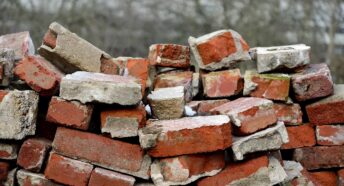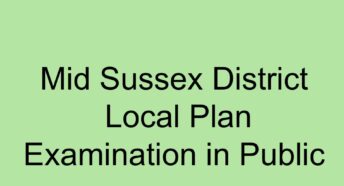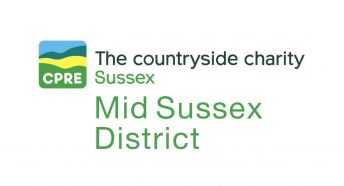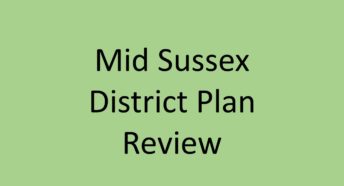Mid Sussex District Update May 2021
I am pleased to be able to report that we have enjoyed a few planning successes here in Mid Sussex in recent weeks.
Whilst it probably doesn’t need saying, I will say it anyway: namely that we at CPRE Sussex cannot claim all the credit. Very often other local individuals or groups have put in far harder yards than we have. Nonetheless in all these cases we have been loud in and detailed in calling out inappropriate development applications, and all these have been long-running cases.
Cuckfield: a visually prominent golf course expansion on a particularly open escarpment outside the village and within the High Weald has been halted in its tracks, and enforcement proceedings are likely to follow if the course owner doesn’t rectify extensive infrastructure works that unwisely jumped the permission gun. For the golfers amongst you, the works that have been refused have no impact on the golf facilities – indeed we supported the proposals for the expansion of the course from 9 to 18 holes.
Horsted Keynes: two separate developer’s appeal hearings against refusal of permission to build on two edge of village sites have both failed, primarily on harm to AONB, landscape and conservation area grounds. CPRE Sussex opposed both planning applications. Great credit to local residents marshalled by Phil Miles for being brave enough, in one case, to appear as rule 6 parties (at considerable cost to their pockets, but not to their good humour). Two alternative village sites are proposed for allocation by Mid Sussex District Council (MSDC), and I am afraid that there is bound to be some controversy over their suitability to deliver the modest additional housing needed locally.
Horsted Keynes: a local landowner who coincidentally also happens to own a waste recycling business has been trying for years to get permission to “improve” a particularly environmentally precious and sensitive corner of the High Weald along the Sussex Border Path where there is a chain of connected ponds and a large, dammed fishing lake. Needless to say, his idea of improvements is in reality a completely unjustified excuse to import large quantities of waste material, none of which is actually needed for the kind of dam strengthening and limited flood prevention work that he claims is required. Under pressure his latest application, like its predecessor, has been withdrawn.
Balcombe: after a decade of threatened oil extraction in the High Weald on the edge of Balcombe village – a fracking threat that back in 2013 generated national publicity and the failed prosecution of Caroline Lucas MP – West Sussex County Council has unanimously refused Angus Energy permission to continue their exploration. Our arguments based primarily on climate change impacts and AONB harm hit home with the planning committee. Unless Angus appeals the residents of Balcombe can at last enjoy unthreatened peace and quiet. We received a lovely e-mail from the Chairman of Frack Free Balcombe Residents Association complementing us on our contribution to securing this significant win (though residents must take the overwhelming credit).
Roadside litter: A word of thanks to one of our local members who has been campaigning hard, and with some success, to get the appalling litter across the District and alongside the A24 cleared up. More power to your elbow Stephen.
Sites Allocation Development Plan Document (SADPD): We are gearing ourselves up for the public examination next month of this adjunct to the District Plan. The SADPD proposes a further 33 sites to be allocated for residential and business development. MSDC’s aim is to be able to demonstrate that they have enough developable sites set aside to meet their required target of building at least 16,390 houses and employment space over the District Plan period.
Our input to the Planning Inspector will concentrate on strengthening air pollution policy, asking for a broad-based coherent climate change policy (the District Plan has none), and opposing a large scale allocation in the High Weald, including a site proposed for 70 houses at Ardingly which exceeds local need and that MSDC has admitted could significantly harm the High Weald. There is an urgent need for more affordable housing for local village communities within the High Weald; but AONBs are not the right place for market housing schemes for which there is no local priority need when there are alternative sustainable locations elsewhere.
AONB conservation: it will not have escaped your notice that all the above successes involved development threats within the High Weald. The importance of protecting the High Weald from inappropriate development is highlighted by two reports commissioned jointly by CPRE and the National Association of Areas of Outstanding Natural Beauty in 2017 and April 2021[1] which together show that the High Weald, along with the Cotswolds, is the most development-pressured AONB in England. Since the introduction of the National Planning Policy Framework (NPPF) in 2012, 15% of all new development allowed in all of England’s 34 AONBs occurs in the High Weald and 77% of that has been permitted on greenfield sites within the High Weald. On sites for 10> homes permission has been granted since 2012 for 3,935 new residential dwellings as at August 2020. (That figure significantly understates the overall position as, unfortunately, we have no AONB-wide data for smaller-scale developments that make up the majority of planning applications).
In Mid Sussex alone (only 11% of the AONB area) permission has been granted under MSDC’s 2014 -2031 District Plan (or is proposed for allocation in the proposed Sites Allocation DPD) for the building of over 1,500 new residential dwellings within the High Weald since 2015.
CPRE is calling for better protection for AONBs, and of the High Weald in particular, including:
– Greater transparency and reliable annual data on cumulative affordable and market housing, and commercial development permitted within AONBs.
– Prioritising small scale affordable and social homes for local people, held by the community in perpetuity, on sustainable AONB sites.
– The public interest in conserving and enhancing AONBs should be prioritised over meeting and delivering on local plan housing targets. Those targets should give more realistic recognition of AONB status as a district wide development constraint.
– AONB partnerships should be treated as statutory consultees on major developments within or in the setting of AONBs, with a requirement for local authorities to give weight to their advice.
– The NPPF should be strengthened to prevent high levels of development in the setting of AONBs, all of which should be of a sensitive scale, location and design and only be permitted if it results in no adverse impacts on the AONB.
– AONB partnerships should be treated as statutory consultees on major developments within or in the setting of AONBs, with a requirement for local authorities to give weight to their advice.
Do please write to your MP if you agree with these simple objectives.
[1] Sources: Beauty Betrayed (2017) and Beauty Still Betrayed (April 2021): Independent reviews of housing in England’s AONBs 2012-2020 jointly by the National Association of AONBs and CPRE: www.cpre.org.uk/resources/beauty-betrayed/





